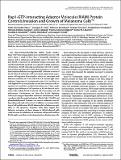Por favor, use este identificador para citar o enlazar a este item:
http://hdl.handle.net/10261/72164COMPARTIR / EXPORTAR:
 SHARE SHARE
 CORE
BASE CORE
BASE
|
|
| Visualizar otros formatos: MARC | Dublin Core | RDF | ORE | MODS | METS | DIDL | DATACITE | |

| Campo DC | Valor | Lengua/Idioma |
|---|---|---|
| dc.contributor.author | Hernández-Varas, Pablo | - |
| dc.contributor.author | Coló, Georgina P. | - |
| dc.contributor.author | Bartolomé, Rubén Álvaro | - |
| dc.contributor.author | Paterson, Andrew | - |
| dc.contributor.author | Medraño-Fernández, Iria | - |
| dc.contributor.author | Arellano-Sánchez, Nohemí | - |
| dc.contributor.author | Cabañas, Carlos | - |
| dc.contributor.author | Sánchez-Mateos, Paloma | - |
| dc.contributor.author | Lafuente, Esther M. | - |
| dc.contributor.author | Boussiotis, Vassiliki A. | - |
| dc.contributor.author | Strömblad, Staffan | - |
| dc.contributor.author | Teixidó, Joaquín | - |
| dc.date.accessioned | 2013-03-14T09:56:34Z | - |
| dc.date.available | 2013-03-14T09:56:34Z | - |
| dc.date.issued | 2011-05-27 | - |
| dc.identifier.citation | Journal of Biological Chemistry 286(2):18492-18504(2011) | - |
| dc.identifier.issn | 0021-9258 | - |
| dc.identifier.uri | http://hdl.handle.net/10261/72164 | - |
| dc.description.abstract | The Mig-10/RIAM/lamellipodin (MRL) family member Rap1-GTP-interacting adaptor molecule (RIAM) interacts with active Rap1, a small GTPase that is frequently activated in tumors such as melanoma and prostate cancer. We show here that RIAM is expressed in metastatic human melanoma cells and that both RIAM and Rap1 are required for BLM melanoma cell invasion. RIAM silencing in melanoma cells led to inhibition of tumor growth and to delayed metastasis in a severe combined immunodeficiency xenograft model. Defective invasion of RIAM-silenced melanoma cells arose from impairment in persistent cell migration directionality, which was associated with deficient activation of a Vav2-RhoA-ROCK-myosin light chain pathway. Expression of constitutively active Vav2 and RhoA in cells depleted for RIAM partially rescued their invasion, indicating that Vav2 and RhoA mediate RIAM function. These results suggest that inhibition of cell invasion in RIAM-silenced melanoma cells is likely based on altered cell contractility and cell polarization. Furthermore, we show that RIAM depletion reduces β1 integrin-dependent melanoma cell adhesion, which correlates with decreased activation of both Erk1/2 MAPK and phosphatidylinositol 3-kinase, two central molecules controlling cell growth and cell survival. In addition to causing inhibition of cell proliferation, RIAM silencing led to higher susceptibility to cell apoptosis. Together, these data suggest that defective activation of these kinases in RIAM-silenced cells could account for inhibition of melanoma cell growth and that RIAM might contribute to the dissemination of melanoma cells. © 2011 by The American Society for Biochemistry and Molecular Biology, Inc. | - |
| dc.description.sponsorship | This work was supported by Grants SAF2008-00479 from the Ministerio de Ciencia e Innovación (to J. T.), Grants SAF2007-60578 and CCG08-UCM/SAL-4259 from the Ministerio de Ciencia e Innovación (to E. M. L.), Grant RETICS RD06/0020/0011 from the Ministerio de Ciencia e Innovación (to J. T.), Grant BFU2007-66443 from the Ministerio de Ciencia e Innovación (to C. C.), a 2006 Grant from the Fundación Ramón Areces (to P. S.-M.), Grant EU-FP7-MetaFight, European Union HEALTH-2007-201,862 (to J. T. and S. S.), a grant from the Swedish Cancer Society and the Swedish Research Council (to S. S.), Grant 2RO1 AI43552 (to V. A. B.), and by a grant from the Fundación de Investigación Científica de la Asociación Española Contra el Cáncer (to R. A. B.). | - |
| dc.language.iso | eng | - |
| dc.publisher | American Society for Biochemistry and Molecular Biology | - |
| dc.relation | info:eu-repo/grantAgreement/EC/FP7/201862 | - |
| dc.rights | openAccess | - |
| dc.title | Rap1-GTP-interacting adaptor molecule (RIAM) protein controls invasion and growth of melanoma cells | - |
| dc.type | artículo | - |
| dc.identifier.doi | 10.1074/jbc.M110.189811 | - |
| dc.relation.publisherversion | http://dx.doi.org/10.1074/jbc.M110.189811 | - |
| dc.identifier.e-issn | 1083-351X | - |
| dc.date.updated | 2013-03-14T09:57:44Z | - |
| dc.description.version | Peer Reviewed | - |
| dc.contributor.funder | Ministerio de Ciencia e Innovación (España) | - |
| dc.contributor.funder | Fundación Ramón Areces | - |
| dc.contributor.funder | European Commission | - |
| dc.contributor.funder | Swedish Cancer Society | - |
| dc.contributor.funder | Asociación Española Contra el Cáncer | - |
| dc.identifier.funder | http://dx.doi.org/10.13039/501100004837 | es_ES |
| dc.identifier.funder | http://dx.doi.org/10.13039/100008054 | es_ES |
| dc.identifier.funder | http://dx.doi.org/10.13039/501100000780 | es_ES |
| dc.identifier.pmid | 21454517 | - |
| dc.type.coar | http://purl.org/coar/resource_type/c_6501 | es_ES |
| item.languageiso639-1 | en | - |
| item.fulltext | With Fulltext | - |
| item.openairecristype | http://purl.org/coar/resource_type/c_18cf | - |
| item.cerifentitytype | Publications | - |
| item.grantfulltext | open | - |
| item.openairetype | artículo | - |
| Aparece en las colecciones: | (CIB) Artículos (CBM) Artículos | |
Ficheros en este ítem:
| Fichero | Descripción | Tamaño | Formato | |
|---|---|---|---|---|
| J. Biol. Chem.-2011-Hernández-Varas-18492-504.pdf | 5,03 MB | Adobe PDF |  Visualizar/Abrir |
CORE Recommender
PubMed Central
Citations
23
checked on 02-abr-2024
SCOPUSTM
Citations
32
checked on 24-abr-2024
WEB OF SCIENCETM
Citations
30
checked on 25-feb-2024
Page view(s)
413
checked on 24-abr-2024
Download(s)
276
checked on 24-abr-2024
Google ScholarTM
Check
Altmetric
Altmetric
Artículos relacionados:
NOTA: Los ítems de Digital.CSIC están protegidos por copyright, con todos los derechos reservados, a menos que se indique lo contrario.
